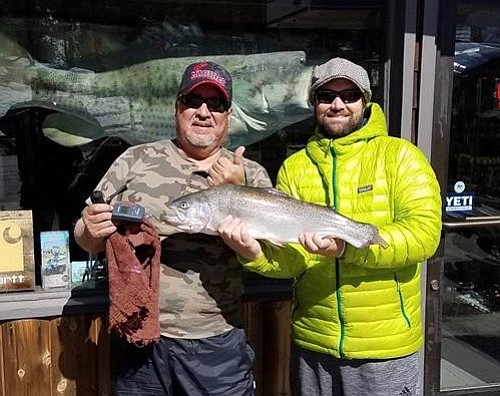 Facebook
Facebook
 X
X
 Instagram
Instagram
 TikTok
TikTok
 Youtube
Youtube

While hundreds of San Diegan anglers wait for the April 29 trout opener in the mountain lakes of the Eastern Sierra, Big Bear Lake, in the nearby San Bernardino Mountains, is producing some large, high country trout this winter.
“There’s no fishing season up here. We’re open year around,” says Steve Rapael, a director of the new Big Bear Lake Fishing Association, a community partnership to enhance and protect the resource.

“Trout are much more active in colder water. And this year, even with snow falling every week or so, the lake has not been frozen over since late January. “We have good runoff from the tributaries, so the trout are [cruising] the shoreline looking for food that’s coming down,” said Rapael.
Gene McCluan, of Del Cerro, fishes Big Bear often. He says it’s best to go out in the morning as early as possible. He uses PowerBait — garlic green and salmon peach are his favorites — with four-pound test line and a #14 treble hook, using an ultralight rod. “But the PowerBait colors can change constantly,” said McCluan. In the evening, McCluan throws flies. “You can see the fish bubbling up everywhere.”
Like most California lakes and resorts facing the Dept. of Fish and Wildlife’s reduction in their stocking program, and the increased, politically charged policy-making that is shifting state regulations from fishing enhancement to one of resource protection, the Big Bear Lake Municipal Water District stepped up to support Big Bear’s visitor-based economy.
Over the last two years, the district has purchased 1.25-million fingerlings from western hatcheries, which are being raised in 11 lakeside pens. The trout, released into the lake at intervals every few months, reach 10 to 12 inches in size before being released.
The district is currently in the permitting process to become its own hatchery. Once operational in 2018, the trout will hopefully be raised to the two- to three-pound size before being released.
With the marinas closed for the winter, anglers will find no competition from trolling boaters. And the cold water keeps the lake’s other species, such as bass, catfish, and bluegill, from being on the prowl.


While hundreds of San Diegan anglers wait for the April 29 trout opener in the mountain lakes of the Eastern Sierra, Big Bear Lake, in the nearby San Bernardino Mountains, is producing some large, high country trout this winter.
“There’s no fishing season up here. We’re open year around,” says Steve Rapael, a director of the new Big Bear Lake Fishing Association, a community partnership to enhance and protect the resource.

“Trout are much more active in colder water. And this year, even with snow falling every week or so, the lake has not been frozen over since late January. “We have good runoff from the tributaries, so the trout are [cruising] the shoreline looking for food that’s coming down,” said Rapael.
Gene McCluan, of Del Cerro, fishes Big Bear often. He says it’s best to go out in the morning as early as possible. He uses PowerBait — garlic green and salmon peach are his favorites — with four-pound test line and a #14 treble hook, using an ultralight rod. “But the PowerBait colors can change constantly,” said McCluan. In the evening, McCluan throws flies. “You can see the fish bubbling up everywhere.”
Like most California lakes and resorts facing the Dept. of Fish and Wildlife’s reduction in their stocking program, and the increased, politically charged policy-making that is shifting state regulations from fishing enhancement to one of resource protection, the Big Bear Lake Municipal Water District stepped up to support Big Bear’s visitor-based economy.
Over the last two years, the district has purchased 1.25-million fingerlings from western hatcheries, which are being raised in 11 lakeside pens. The trout, released into the lake at intervals every few months, reach 10 to 12 inches in size before being released.
The district is currently in the permitting process to become its own hatchery. Once operational in 2018, the trout will hopefully be raised to the two- to three-pound size before being released.
With the marinas closed for the winter, anglers will find no competition from trolling boaters. And the cold water keeps the lake’s other species, such as bass, catfish, and bluegill, from being on the prowl.
Comments